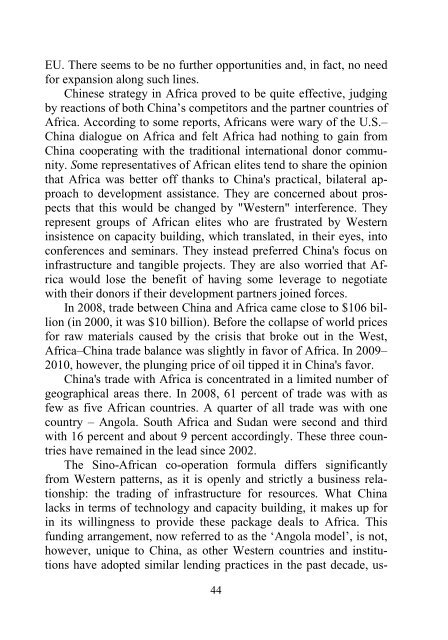L. Fituni, I. Abramova Resource Potential of Africa and Russia's ...
L. Fituni, I. Abramova Resource Potential of Africa and Russia's ...
L. Fituni, I. Abramova Resource Potential of Africa and Russia's ...
Create successful ePaper yourself
Turn your PDF publications into a flip-book with our unique Google optimized e-Paper software.
EU. There seems to be no further opportunities <strong>and</strong>, in fact, no need<br />
for expansion along such lines.<br />
Chinese strategy in <strong>Africa</strong> proved to be quite effective, judging<br />
by reactions <strong>of</strong> both China’s competitors <strong>and</strong> the partner countries <strong>of</strong><br />
<strong>Africa</strong>. According to some reports, <strong>Africa</strong>ns were wary <strong>of</strong> the U.S.–<br />
China dialogue on <strong>Africa</strong> <strong>and</strong> felt <strong>Africa</strong> had nothing to gain from<br />
China cooperating with the traditional international donor community.<br />
Some representatives <strong>of</strong> <strong>Africa</strong>n elites tend to share the opinion<br />
that <strong>Africa</strong> was better <strong>of</strong>f thanks to China's practical, bilateral approach<br />
to development assistance. They are concerned about prospects<br />
that this would be changed by "Western" interference. They<br />
represent groups <strong>of</strong> <strong>Africa</strong>n elites who are frustrated by Western<br />
insistence on capacity building, which translated, in their eyes, into<br />
conferences <strong>and</strong> seminars. They instead preferred China's focus on<br />
infrastructure <strong>and</strong> tangible projects. They are also worried that <strong>Africa</strong><br />
would lose the benefit <strong>of</strong> having some leverage to negotiate<br />
with their donors if their development partners joined forces.<br />
In 2008, trade between China <strong>and</strong> <strong>Africa</strong> came close to $106 billion<br />
(in 2000, it was $10 billion). Before the collapse <strong>of</strong> world prices<br />
for raw materials caused by the crisis that broke out in the West,<br />
<strong>Africa</strong>–China trade balance was slightly in favor <strong>of</strong> <strong>Africa</strong>. In 2009–<br />
2010, however, the plunging price <strong>of</strong> oil tipped it in China's favor.<br />
China's trade with <strong>Africa</strong> is concentrated in a limited number <strong>of</strong><br />
geographical areas there. In 2008, 61 percent <strong>of</strong> trade was with as<br />
few as five <strong>Africa</strong>n countries. A quarter <strong>of</strong> all trade was with one<br />
country – Angola. South <strong>Africa</strong> <strong>and</strong> Sudan were second <strong>and</strong> third<br />
with 16 percent <strong>and</strong> about 9 percent accordingly. These three countries<br />
have remained in the lead since 2002.<br />
The Sino-<strong>Africa</strong>n co-operation formula differs significantly<br />
from Western patterns, as it is openly <strong>and</strong> strictly a business relationship:<br />
the trading <strong>of</strong> infrastructure for resources. What China<br />
lacks in terms <strong>of</strong> technology <strong>and</strong> capacity building, it makes up for<br />
in its willingness to provide these package deals to <strong>Africa</strong>. This<br />
funding arrangement, now referred to as the ‘Angola model’, is not,<br />
however, unique to China, as other Western countries <strong>and</strong> institutions<br />
have adopted similar lending practices in the past decade, us-<br />
44







